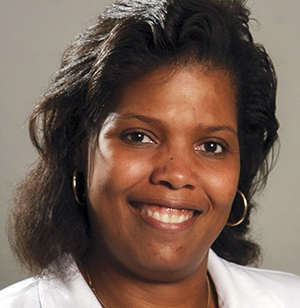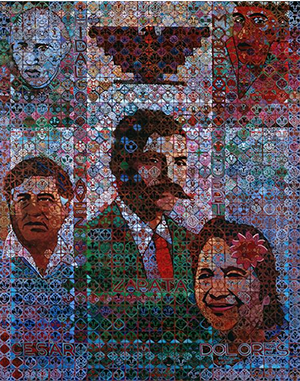Jean Andino can never forget the wide-eyed look of shock on students’ faces.
She’d been invited to speak to students affiliated with the City College of New York’s Louis Stokes Alliance for Minority Participation Program. In her talk, she described her life growing up in a struggling neighborhood in the Bronx, a borough of New York City where college can seem like an impossible dream.
Yet Andino not only went to college, she earned a prestigious Ivy League degree in engineering sciences at Harvard University and a doctorate in chemical engineering at the California Institute of Technology.
“You grew up where?” students asked. “And you still made it to Harvard? How did you do that?”
Throughout her career, Andino, interim director of Arizona State University's Hispanic Research Center and associate professor in the School for Engineering of Matter, Transport and Energy, defied the odds to find success.
She was the first woman to be promoted and tenured in the history of the Environmental Engineering Sciences program at the University of Florida. A Puerto Rican, she received a Society of Hispanic Professional Engineers STAR Educator of the Year Award in 2017, when she estimated she was one of only 15 mainland U.S.-born Latinas in tenured or tenure-track engineering faculty positions in the nation.
She’s earned numerous prestigious national awards, including a Fulbright U.S. Scholar Award, three NASA Space Act Awards and a National Science Foundation CAREER Award.
Jean Andino
To honor National Hispanic Heritage Month, which runs Sept. 15 to Oct. 15, we spoke to Andino about her trailblazing career and why she’s so passionate about her role at the Hispanic Research Center. The research unit of The College of Liberal Arts and Sciences serves as a hub for academic exploration and distribution of resources in areas of importance to the Hispanic culture, both at the university and the community at large.
“The Hispanic Research Center is important because it provides a forum for people to understand the great diversity that exists within the Hispanic culture,” she said.
Home to an extensive collection of work by Hispanic artists, the center has showcased its collection through a variety of art shows, exhibitions and tours. For the first time in its 35-year history, the center is now hosting a virtual art exhibit titled “Mixing It Up.”
Alfredo Arreguín's painting "Return to Aztlán," featured in the "Mixing It Up" virtual art exhibit.
“As an engineer, I’m a big tech fan, so a virtual art exhibit totally makes sense,” she said. “Despite the pandemic, there still are some incredible opportunities to make connections where we might not normally make connections.”
Andino knows the value of connections in life. As she navigated her successful academic and professional career, trusted mentors were always by her side.
At the Bronx High School of Science, she first discovered her passion for engineering in a physics class that combined learning science with real-life applications. She honed her skills in mechanical drafting and created a cigar box ukulele as her first design build.
“As a high schooler, taking science and applying it was the start of everything for me,” she said.
“When I left Harvard, I felt like I had the theoretical background I needed to succeed,” she said. “Harvard prepared me very well — to be broadminded in my engineering thinking and to be able to relate to people of different backgrounds. What I didn’t feel like I had was the full confidence to take some of that knowledge and translate it into something useful for the engineering field.”
She entered the male-dominated auto industry to work at Ford Motor Company, where her work focused on removing air pollutants. She characterized the reactions taking place on novel materials to be used in catalytic converters and determining the ambient air quality impacts of fuels and alternative fuels. After working for Ford for two years, she deepened her expertise at the California Institute of Technology, where she earned a doctorate degree in chemical engineering and her adviser encouraged her to teach at the university level.
At ASU, Andino and her research team develop innovative solutions to air quality issues, such as air pollution control techniques and devices and pollutant-sensing technologies. Actively engaged in patenting and commercialization efforts, she is also a prolific author of journal articles and has served on high-profile boards, including multiple National Academies panels.
As an associate professor, she teaches classes on air quality engineering and chemical reactor design, among others. She says one of her most rewarding roles is serving as a mentor to all students, particularly those who are traditionally underrepresented in science and engineering.
At her talk at the City College of New York, she first heard the magical words: “You’ve inspired me to go one step further than I would have thought of going.”
“Those are the conversations I live for as a faculty member,” said Andino, who relishes telling her story to underrepresented students to empower them to pursue their dreams and accomplish their goals. “Other than teaching, where else can you get that type of experience?”
5 noteworthy Hispanic and Latino contributions to society
We asked Andino for her top five picks of Hispanic and Latino contributions to American society.
- La Borinqueña, the first Latina superhero, featured in the Smithsonian in Washington, D.C. (La Borinqueña is also the title of Puerto Rico’s national anthem.)
- Sonia Sotomayor, the first Hispanic and Latina member of the U.S. Supreme Court.
- The cybersecurity CAPTCHA technology invented and patented by Luis von Ahn from Guatemala.
- Musical artists that have influenced genres, including Marc Anthony (Puerto Rican), Celia Cruz (Cuban), Tito Puente (Puerto Rican from New York City), Rubén Blades (Panamanian) and El Gran Combo de Puerto Rico.
- The patent for a chemical that forms the basis of one of the first oral contraceptives was invented by a chemist from Mexico, Luis Miramontes.
What’s the difference between Hispanic and Latino?
Hispanic and Latino are often used interchangeably, though they actually mean different things.
- Latino refers to a person of Latin American descent who is living in the U.S. “Latinx” is also sometimes used as a gender-neutral term in lieu of Latino or Latina.
- Hispanic describes a person who speaks Spanish, descended from a Spanish-speaking country, or both.
More Science and technology

ASU professor breeds new tomato variety, the 'Desert Dew'
In an era defined by climate volatility and resource scarcity, researchers are developing crops that can survive — and thrive —…

Science meets play: ASU researcher makes developmental science hands-on for families
On a Friday morning at the Edna Vihel Arts Center in Tempe, toddlers dip paint brushes into bright colors, decorating paper…

ASU water polo player defends the goal — and our data
Marie Rudasics is the last line of defense.Six players advance across the pool with a single objective in mind: making sure that…




